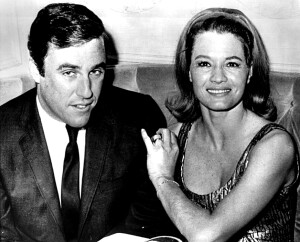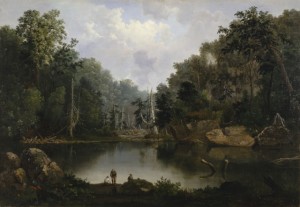- It Took A Musician’s Ear To Decode The Complex Song In Whale Calls : NPR 080615
Humpback whales don’t just sing songs — they compose with the whales around them, singing a song that evolves over time. Scientists didn’t know that until they started recording whale sounds in the 1960s and spent years listening. The evolution of this “culture of listening” among researchers is the focus of Morning Edition’s weekly summer series, Close Listening: Decoding Nature Through Sound. | Katy Payne, a researcher in acoustic biology at the Cornell Lab of Ornithology, and her husband, Roger, were the first scientists to realize that the intricate and eerie calls of some humpback whales are actually songs. At a recent visit with Katy in a Cornell sound studio, we played this archived recording of the first whale they ever heard, and she recognized it right away: | “It’s the voice of a male humpback whale off shore of Bermuda, in 1964,” Katy explained. “It was recorded by a Navy engineer.” |The Paynes met the engineer, Frank Watlington, on a trip to Bermuda. A friend of theirs had recommended they look him up because he shared their passion for whales, and Watlington invited the Paynes aboard his ship. | “We had no idea we were going to hear anything,” Payne told us. “He said, ‘I don’t suppose you’ve ever heard the sounds these animals make?’ ” |And then he played the song of the humpback whale for them. |”I had never heard anything like it,” Katy said. “Oh, my God, tears flowed from our cheeks. We were just completely transfixed and amazed because the sounds are so beautiful, so powerful — so variable. They were, as we learned later, the sounds of just one animal. Just one animal.”
- The search for the next great bee | Michigan Radio 080415
Honey bees pollinate about a third of the crops in the U.S—that’s about $15 billion of the agricultural economy. But honeybees have had a tough time lately: a combination of diseases, stress, parasites and pesticides have all hurt the honey bee population. | Scientists are starting to look at how other species of bees could help pick up the slack. | The bee world is a lot bigger than just honey bees; in fact, there are more than 20,000 species of bees in the world. Penn State researchers like Dave Biddinger are finding out that some of these unsung bees could start filling gaps left by honey bees.
- One Of The Nation’s Biggest Urban Forests Isn’t Where You’d Expect : NPR 080615
WADE GOODWYN: “The Trinity Forest is a place that’s in the process of becoming. What it’s becoming isn’t completely clear yet. We walk through acres of meadows, forest, river bottom. Massive hardwood soar above our heads. But at spots along the Trinity River, it’s disgusting. Because this place is both remote and close to Dallas, forest advocate Ben Sandifer says it’s long been a dumping ground. | Jack likes being outside all morning, the fishing hiking, birding, insecting. I just made that word up. And going to the Dallas Zoo beats being bored at home. But it’s not all good. There’s the bad and the ugly, too. Eleven-year-old Dylan Malone says she was dismayed at the condition of the riverbank while they were kayaking.”
- My township calls my lawn ‘a nuisance.’ But I still refuse to mow it. – The Washington Post 080415
Sarah Baker: “In June, my partner and I received an official written warning from the trustee board of St. Albans Township, stating that our yard had become “a nuisance.” Ohio law allows local governments to control any vegetation on private property that they deem a nuisance, after a seven-day warning to the property owners. But the law does not define what “a nuisance” is, effectively giving local leaders the power to remove whatever grass or plants offend them. In our case, the trustees decided that our lawn was too tall and thick and would attract “nuisance animals” such as “snakes and rodents.” If we didn’t cut it, they would hire someone to do so and bring law enforcement with them. | But the main point of growing a natural yard is to attract wildlife and build a self-regulating environment. The un-mowed plants in our yard attract plant-eating bugs and rodents, which in turn attract birds, bats, toads and garter snakes that eat them. Then hawks fly in to eat the snakes. Seeing all this life emerge in just one growing season made me realize just how much nature manicured lawns displace and disrupt. | There are 40.5 million acres of lawn in the United States, more than double the size of the country’s largest national forest. We disconnect ourselves from wildlife habitat loss by viewing it as a problem caused by industry and agriculture. But habitat loss isn’t a problem happening out there somewhere; it’s happening in our own back yards. | This has serious consequences. About 95 percent of the natural landscape in the lower 48 states has been developed into cities, suburbs and farmland. Meanwhile, the global population of vertebrate animals, from birds to fish, has been cut in half during the past four decades. Honey bees, which we depend on to pollinate our fruits and other crops, have been dying off at an unsustainable rate. Because one in three bites of food you take requires a pollinating insect to produce it, their rapid decline is a threat to humanity. Monarch butterflies have been even more affected, with their numbers dropping 90 percent since the 1990s. Butterflies are an important part of the food chain, so ecologists have long used them to measure the health of ecosystems. | Nature preserves and parks are not enough to fix the problem; much of wildlife is migratory and needs continuous habitat to thrive. Natural yards can act as bridges between the larger natural spaces.
- Is Your Lawn Giving You A Hard Time? Let It Grow : NPR 080515
Sarah Baker’s yard is a nuisance. At least that’s what the trustees of her township in central Ohio say. Baker and her partner have been letting their yard grow wild. They haven’t mowed it since last year. Now the Baker’s yard care has become the subject of national debate. Sarah Baker joins me to talk about both the outrage and the support that have germinated from her wild yard.
About the Ghost Turtles
150 years after Robert Duncanson painted this luminist scene on the Little Miami River, I stood in the same spot and saw a soft-shelled turtle sunning on a snag. It slipped silently into the water when it heard me. That’s when I knew past is present and destiny, too. That’s when my vision of the Ghost Turtles began. Read more
Ecology of the Senses
 Returning to Lake Superior year after year like a migrating loon, I’ve learned the other side of a slow, uncertain process that could be called “going blind.” With the lake as my teacher, I know what lies on the other side. I call it letting go of sight. Read more.
Returning to Lake Superior year after year like a migrating loon, I’ve learned the other side of a slow, uncertain process that could be called “going blind.” With the lake as my teacher, I know what lies on the other side. I call it letting go of sight. Read more.Prayer at Big Creek
![Sandhill cranes land on Platte River sandbar roosts west of Rowe Sanctuary’s Iain Nicolson Audubon Center southwest of Gibbon, Nebraska. [Photo by Lori Porter| Kearney Hub]](https://www.ghostturtles.com/wp-content/uploads/2015/03/sandhill_cranes_kearneyhub_032015-300x225.jpg) At the threshold of consciousness, as I slipped back and forth between two worlds, I put my mind in the best place I could imagine, a marsh on Lake Erie called Big Creek. I knew I’d find cranes waiting for me. I cannot say whether I prayed for them, or to them, or with them. The cant of words doesn’t matter. I believe in the still, small voice. I believe what the poet Yehuda Amichai said. Gods come and go. Prayer is eternal. Read more
At the threshold of consciousness, as I slipped back and forth between two worlds, I put my mind in the best place I could imagine, a marsh on Lake Erie called Big Creek. I knew I’d find cranes waiting for me. I cannot say whether I prayed for them, or to them, or with them. The cant of words doesn’t matter. I believe in the still, small voice. I believe what the poet Yehuda Amichai said. Gods come and go. Prayer is eternal. Read moreFreedom to Read
![An endangered Whooping crane takes flight. Yhe large bird has a 7-foot wingspan. It is all white except for black wing tips and face markings. In this photo its long neck stretches forward; its wings sweep upward; and its black legs trail straight behind it. [Source: International Crane Foundation]](https://www.ghostturtles.com/wp-content/uploads/2023/03/Whooping-crane-eastern-ICF-080622-300x157.jpg) Whenever I hear sanctimonious pronouncements about woke, parental rights, and banning books, I think of Whooping cranes. In my family, the gawky, audacious, elusive and endangered birds are synonymous with our values about the First Amendment and the freedom to read. Read more.
Whenever I hear sanctimonious pronouncements about woke, parental rights, and banning books, I think of Whooping cranes. In my family, the gawky, audacious, elusive and endangered birds are synonymous with our values about the First Amendment and the freedom to read. Read more.Sister, Teacher, Pathfinder
 A guidance counselor in high school told my sister Diana, “With your eye problems you will never make it in college. Just forget about it. Get married. Raise a family.” That advice only deepened her determination. She did it all in due time, in her own way –college, marriage, family. She became a guidance counselor herself. She certainly was the most important guide and pathfinder in my life. Read more.
A guidance counselor in high school told my sister Diana, “With your eye problems you will never make it in college. Just forget about it. Get married. Raise a family.” That advice only deepened her determination. She did it all in due time, in her own way –college, marriage, family. She became a guidance counselor herself. She certainly was the most important guide and pathfinder in my life. Read more.Flaneur & Bouquiniste
![Mark Willis peruses a 1745 volume by Voltaire at a bouquiniste book stall on the banks of the Seine in Paris. He wears a brown leather jacket and checkered flat cap. He holds the open book in his hands. Rows of old books are seen on shelves behind him. [2005 photo by Ms. Modigliani]](https://www.ghostturtles.com/wp-content/uploads/2023/03/mw_bouquiniste_05-300x225.jpg) I remember the book I held in my hands that day. I remember the feel of its time-warped, water-stained pages. I remember its murky, moldy river smell, call it the book’s bouquet, suggesting years of storage on the banks of the Seine. Had I bought it then, I could feel and smell it now and know it from a hundred other books in my library. Read more.
I remember the book I held in my hands that day. I remember the feel of its time-warped, water-stained pages. I remember its murky, moldy river smell, call it the book’s bouquet, suggesting years of storage on the banks of the Seine. Had I bought it then, I could feel and smell it now and know it from a hundred other books in my library. Read more.R & K: A Rant
 Marjorie Taylor Green auditioned for R&K’s Authoritarian It Girl at the 2023 State of the Union address. She and her Republican colleagues yelled like Tarzan swinging through the trees as they jeered and booed the President’s speech. Read Rants & Kisses.
Marjorie Taylor Green auditioned for R&K’s Authoritarian It Girl at the 2023 State of the Union address. She and her Republican colleagues yelled like Tarzan swinging through the trees as they jeered and booed the President’s speech. Read Rants & Kisses.R & K: A Kiss
 Songs by Burt Bacharach and Hal David. Singers like Dione Warwick and Dusty Springfield. What Do You Get When You Fall in Love? The Look of Love. I Say a Little Prayer. I sit in the car’s back seat and listen. I’m glad it’s dark. I’d be embarrassed if anyone could see the dreamy look on my face. Read Rants & Kisses.
Songs by Burt Bacharach and Hal David. Singers like Dione Warwick and Dusty Springfield. What Do You Get When You Fall in Love? The Look of Love. I Say a Little Prayer. I sit in the car’s back seat and listen. I’m glad it’s dark. I’d be embarrassed if anyone could see the dreamy look on my face. Read Rants & Kisses.

